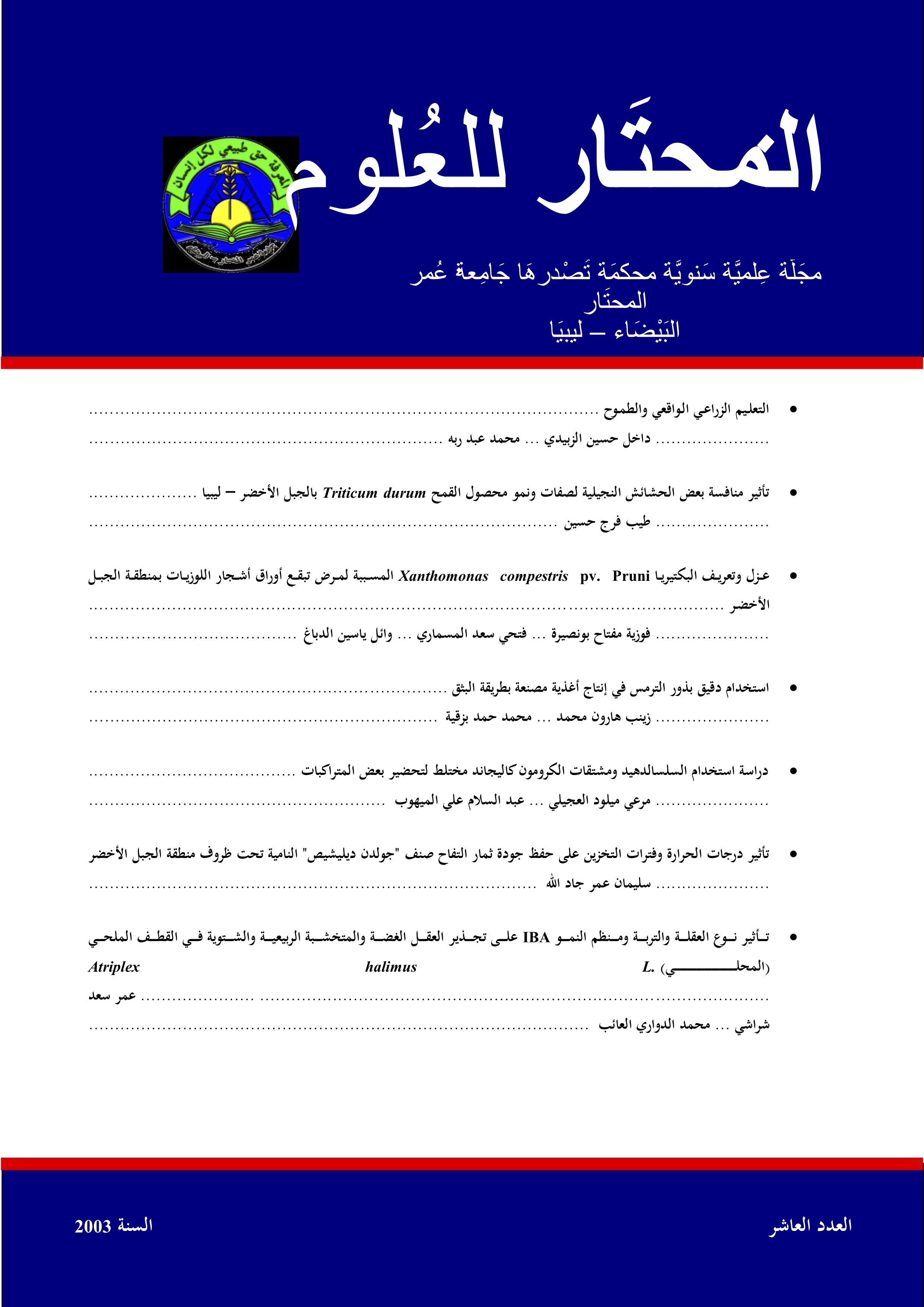Association of the bacteria Xanthomonas campestris pv. pruni with leaves spot disease in Green Mountin District
DOI:
https://doi.org/10.54172/mjsc.v10i1.502Keywords:
Xanthomonas campestris pv. pruni , leaves spot disease, Green Mountin , LibyaAbstract
A survey conducted during spring 1997 of the diseases effecting stone fruit trees in Green Mountain district, revealed awide spread of leaf spot disease on Almond, Peach, Plum and Apricot trees. Subsequent studies on pathogenicity, morphological and physiobiochemical properties of the causal agent, indicated the association of the bacteria xanthomonas campestris pv. pruni with the disease symptoms. Studies on the host range showed that all isolates of the bacteria were able to infect and produce the typical disease symptoms on the leaves of peach, Amond, Plum, Cherry, Apple and Rose but not on the varity stanley of Plum and Bitter Almond varities. The bacterium was also found to survive the winter season in the flower buds and to retain its infectivity in diseased leave tissues for eight months which consequently provide a source of primary inoculm for spring infection of newly emerging leaves.
Downloads
References
أبو الذهب ، م والجعفراني ، م (1984) . البكتيريا : التمارين المعملية الأساسية ، دار المعارف القاهرة ، 130-177 .
العوامي ، ع (1996) ، دراسات على مرض التبقع البكتيري على نباتات الطماطم ، رسالة ماجستير ، كلية الزراعة ، جامعة عمر المختار ، 13-45 .
آمال أبو العلا (1999) ، فيروس جدري الخوخ على أشجار اللوزيات في مصر ، مجلة وقاية النبات العربية ، مجلد 17 ، 94 .
زكي ، س (1988) ، الميكروبيولوجيا التطبيقية المعملية ، مكتبة الأنجلو المصرية ، القاهرة ، 44-130 .
حنا ، د (1984) ، فاكهة المناطق المعتدلة ، مديريةدار الكتاب للطباعة والنشر ، جامعة الموصل ، العراق ، 25-60 .
سيالة ، ع (1990) ، مذكرات في الدراسات البكتيريولوجية المعملية ، كلية العلوم ، جامعة الفاتح ، طرابلس ، 120-166 .
عبد الرحيم ، ع (1996) ، البكتيريا وأمراض النبات ، منشورات جامعة عمر المختار البيضاء ، 287-320 .
عبد الوهاب ، م (1989) ، الكائنات الدقيقة معملياً ، دار العرب للنشر والتوزيع ، القاهرة ، 100-167 .
عقل ، م (1999) ، الوضع الراهن للأمراض الفيروسية على أشجار اللوزيات . مجلة وقاية النبات العربية ، مجلد ، 17 ، 94 .
Anderson, P.C. and W.B. Sherman, (1995). New low chill peach and nectarine cultivars. University of Florida State Horticultural Society Meeting U.S.A 107: 1331-333.
Bradbury, J.F. (1986), Guide to plant pathogenic bacteria, CAB International Mycological Institute. Ferrylone, Kew. Surrey England.
Cappuccino, J.G. & Sherman, N (1992). Microbiology: Laboratory Manual. Rockland Community Collage, Suffern, New York.
Dhingra, O.D. & Sinclair, J.B. (1995). Basic Plant Pathology Methods. 2nd. ed. Lewis Publisher, Baco Raton, London.
Du-Plessis, H.J. (1987). Canker development on plum shoots following systemic movement of Xanthomonas campestris pv. pruni from inoculated leaves. (Abst) Rev. plant pathol. 67: 379.
Fahy, P.C. (1983). Plant Bacterial Diseases, A diagnostic Guide. Academic Press INC. 107-188.
Goodman, R.N. (1968). The hypersensistive reaction in tobacco: Areflection of changes in host cell prmeability. Phyto pathol., 58: 872-873.
Goodman, R.N. (1972). Electrolyte leakge and membrane damage in relation to bacterial population, pH and ammonia in tobacco leaf tissue inoculated with P. seudomonas pisi. Phytopathology, 62: 1331-1334.
Hammerschlag, F.A. (1984). Optical evidence for an effect of culture filterates of Xanthomonas campestris on peach mesophlly cell memberanes. Plant. Sci. lett, 34: 295-304.
Hayword, A.C. et al., (1965). Xanthomonas campestris pv. pruni C.M.I. Description of Pathogenic Fungi & Bacteria. No. 50.
Holt, J. and S.T. William. (1994). Bergey’s Manual of Determinative Bacteriology. 9th ed., Williams, U.S.A. 100-173.
Jindal, K.K. & R.C. Sharma. (1988). Occurrence of bacterial leaf spot of peach incited by Xanthomonas campestris pv. pruni. Rev. plant pathol. 1989. 68: 10.
Jones, J.B. and Scott. J.W. (1986). Hypersensitive response in tomato to Xanthomonas campestris pv. vesicatoria. Plant Dis. 70: 337-339.
Kiraly, Z. Klement, Z. Solymosy, F. and Voros, J. (1974). Methods in plant pathology. Elsevier Scientific Publishing Company. 117-178.
Lelliott, R.A. and Stead, D.E. (1987). Methods for the diagnosis of plant pathogenic bacteria. Blackwell Scientific publications, London. 66-197.
Mulrrean, A.N. and Schroth, M.N. (1982). Ecology of Xanthomonas campestris pv. juglandis on persian English walnuts. Phytopathol. 72: 434-438.
Norris, J.R. and Ribbons, J.R. (1971). Methods in Microbiology. Academic Press, London.
Sahin, F. and Miller, S.A. (1996). Characterization of Ohio strains of Xanthomonas campestris pv. vesicatoria. Causal agent of bacterial spot of pepper. Plant. Dis., 80: 773-778.
Schaad, N.W. (1980). Laboratry guide for identification of plant pathogenic Bacteria. The American phytopathological Society.
Simeone, A.M. (1990). Observation on cultivar suscptibility of plum collection to natural infection by Xanthomonas campestris pv. pruni. Rivista-di-frutticoltura-e-di-ortofloricoltura 52: 61-63.
Young, J.M. (1974). Effect of water on bacterial multiplication in plant tissue N.Z.J. Agric. Res., 17: 115-119.
Zehr, E.I.; Shepard, D.P. and W.C. Bridges. Bacterial spot of peach as influenced by water congestion, leaf wetness duration and temperture: plant-Dis., 80: 339-341.
Downloads
Published
How to Cite
License
Copyright (c) 2021 Fawzia M. Abonesira, Fathi S. AlMesmari, Wail Y. AlDabbgh

This work is licensed under a Creative Commons Attribution-NonCommercial 4.0 International License.
Copyright of the articles Published by Almukhtar Journal of Science (MJSc) is retained by the author(s), who grant MJSc a license to publish the article. Authors also grant any third party the right to use the article freely as long as its integrity is maintained and its original authors and cite MJSc as original publisher. Also they accept the article remains published by MJSc website (except in occasion of a retraction of the article).










